Sella Turcica
Anatomy of Sella Turcica
Sella turcica resembles as saddle-like depression, which provide place for the pituitary gland. Anatomically, the sella turcica has been expressed as variable.
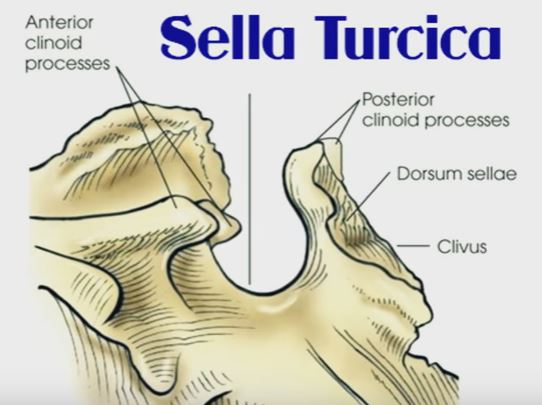
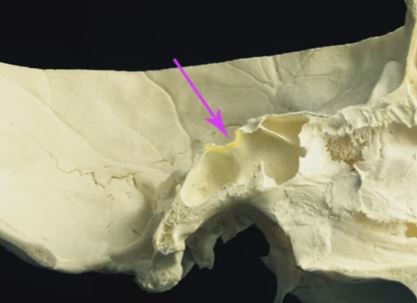
Figure 1, 2 – saddle-like depression which is sella turcica
It is divided into three fragments and consists of an anterior wall, a floor, and a posterior wall.
The posterior surface of attached with membrane, which is termed as dorsum sellae amd the anterior order is attached with the tuberculum sellae. The whole sellar area is made up of
- Optic Chiasma
- Pituitary Gland
- Internal Carotids
- Cavernous sinusand cranial nerves
- Sphenoid Sinuses
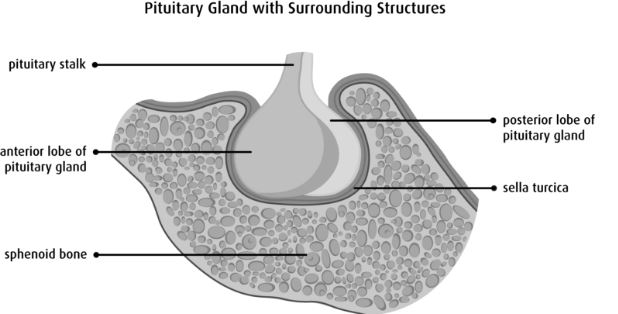
The complex anatomical changes are made in sellar region in case of neoplastic process.(1,2,4)
Location (site) of Sella Turcica
The cranial base of the skull is supported by sphenoid bone, which is looks like a butterfly. Sella turcica, cross-sectional depression present at the mid line of the sphenoid bone. The exact location can be described as sella turcica present just at the back of the void space identified as the sphenoid sinus, which sits it in the region of the center of the base of the cranium. (1,3,4)
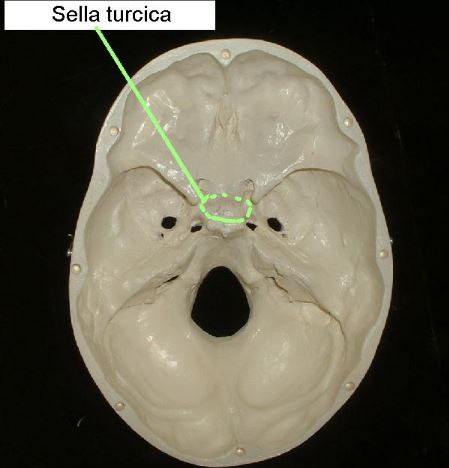
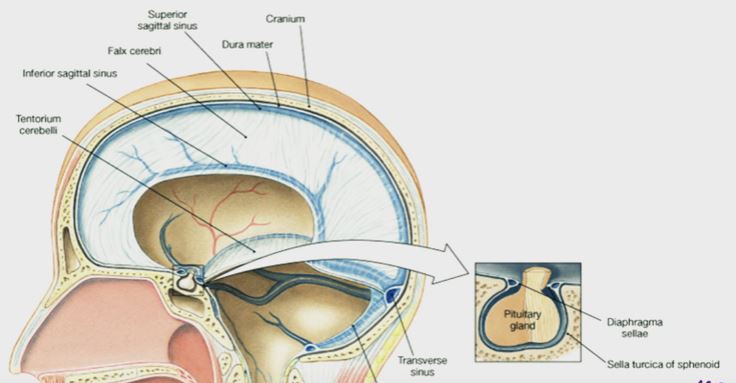
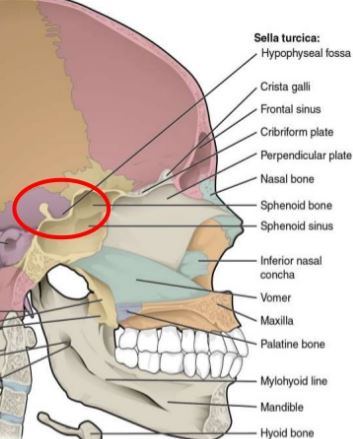
Location of sella turcica in skull
Functions of Sella Turcica
Providing the proper place to hold and support the pituitary gland. (3)
Clinical Anatomy of Sella Turcica
Any anomaly or pathological condition in the pituitary gland can apparent from a distorted form of sella turcica, to a disorder in the malfunctioning of the secretion of the hormones secreted by the pituitary, which includes growth hormones (GH), thyroid stimulating hormone (TSH), prolactin, follicular stimulating hormone (FSH), and others. (6)
Empty sella turcica
In normal condition, the pituitary gland is closely fitted within sella turcica. In empty sella turcica, due to the shrinkage and flattened of pituitary gland, the size of the sella turinica appears relatively larger, though the actual size of the sella turinica actually remain normal.
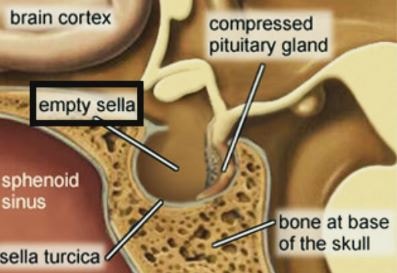
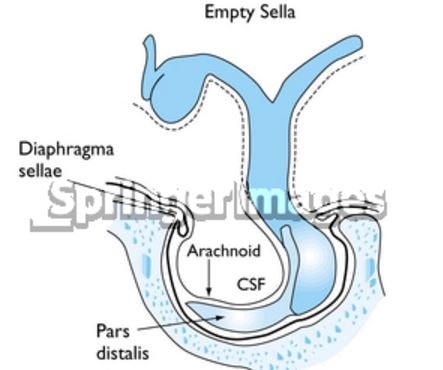
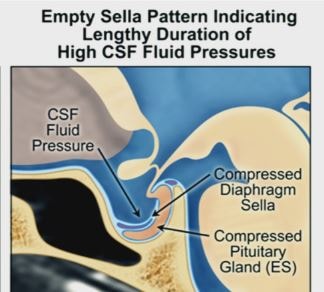
The size of the pituitary gland does not affects it function, but in some cases shrinkage of the pituitary gland causes hypopituitarism and leads to under activity of the hormones secrete from pituitary gland due to insufficiency.
Clinical pathology states that due to the weakness of the diaphragma sellae, which is the covering of the pituitary gland and acts to provide barrier of flow to cerebrospinal fluid (CSF) into the sella turcica, and resultant effect shows leakage of the CSF into the sella turcica.
The excessive amount of this fluid provides pressure to the pituitary gland and become shrink in size. This appears as empty space present in the sella turcica and termed as empty sella turcica.
Empty sella defined as an enlargement or deformity of sella turcica that is completely or partially filled with CSF (cerebrospinal fluid). In fact, the expression ’empty sella’ is a not accurate, as the sella is not entirely vacant. The pituitary is constantly present both anatomically and physiologically, though it is dislocated downwards and squeezed by the pressure of cerebrospinal fluid.
An empty sella is often an subsidiary anatomical shift and sporadically it consequences in anomalous pituitary function. Despite of the volume, the sella is partially or completely packed with cerebrospinal fluid. It can arise at any age and is not a gender specific condition, though the incidence rate is more in women with increasing age. The different causes associated with Empty sella are as follows:
- Congenital nonappearance of the diaphragma sellae
- Incomplete formation of diaphragma sellae
- Expansion of the suprasellar subarachnoid space.
The secondary empty sella syndrome develops, when the pituitary fossa turn into empty due to the surgical removal of the pituitary gland or radiation therapy causes damage in the pituitary gland. Presence of pituitary tumor can cause tissue necrosis or pituitary gland becomes shrink due to internal hemorrhage.
The primary empty sella syndrome is most common in obese female and does not provide any symptom. Usually it is detected, when any other associated condition is diagnosed. Usually affecting individual complain chronic headache due to intracranial pressure. Other rare obtainable lists of symptoms are:
- Steady flow of cerebrospinal fluid through the nasal cavity (Cerebrospinal rhinnorhea)
- Visual disturbance due to inflammation of the optic disc or papilledema
- Erectile dysfunction
- Absence or irregular menstruation cycle
- Low libido or decease sexual urge
- Tiredness due to low energy level
- Secretion from nipple due to hyperprolactemia
- Early onset of empty sella syndrome in the childhood can cause inhibition of growth due to shortage of GH (growth hormone).
The lateral X-ray of the head may expose the enlargement of the sella. CT scans (computerised tomography scans) can provide the image of the pituitary fossa filled up with large quantity of watery fluid or CSF. MRI (Magnetic resonance imaging) can provide a confirmatory diagnosis of an empty sella.
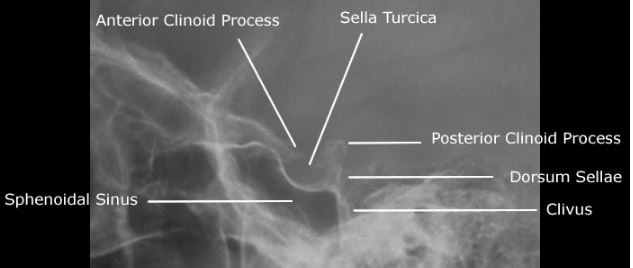
No treatment is usually need. In case of hormonal imbalance, hormonal replacement therapy need to correct the hormonal balance.
For excessive secretion with symptoms of cerebrospinal rhinnorhea or papilledema, the correction is made by chiasmopexy technique. Surgical intervention is rarely needed. (4,7)
Pictures
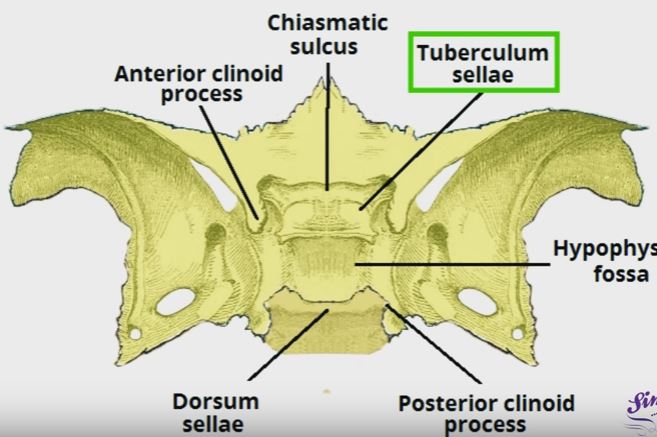
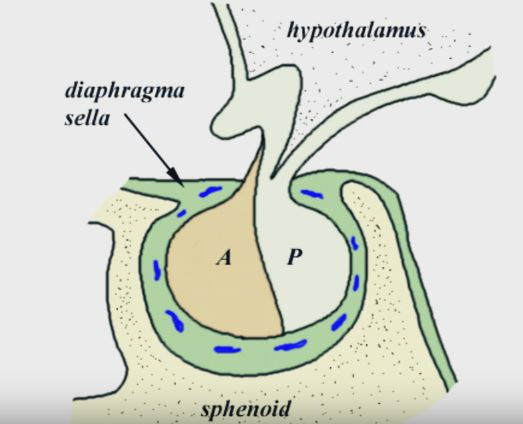
References
- Gillian Leiberman; Imaging The Turkish Saddle; Retrieve from: http://eradiology.bidmc.harvard.edu/LearningLab/central/Goodman.pdf
- ALBERT L. RHOTON, JR.; Anatomy of the Pituitary Gland and Sellar Region; Retrieve from: http://www.springer.com/978-0-89603-403-7
- What is the Sella turnica; Retrieve from: http://www.wisegeek.com/what-is-the-sella-turcica.htm
- Tekiner H, Acer N, Kelestimur F. (2015); Sella turcica: an anatomical, endocrinological, and historical perspective; Retrieve from: http://www.ncbi.nlm.nih.gov/pubmed/25307180
- Empty sella syndrome (2014); Retrieve from: http://www.yourhormones.info/endocrine_conditions/empty_sella_syndrome.aspx
- Haritha Pottipalli Sathyanarayana, Vignesh Kailasam, and Arun B Chitharanjan (2013); Sella turcica-Its importance in orthodontics and craniofacial morphology; Retrieve from: http://www.ncbi.nlm.nih.gov/pmc/articles/PMC3858728/
- JK Agarwal, RK Sahay, SK Bhadada, Vijay Sekhar Reddy, NK Agarwal (2001); Empty Sella Syndrome; Journal, Indian Academy of Clinical Medicine; Vol. 2, No. 3; Retrieve from: http://medind.nic.in/jac/t01/i3/jact01i3p198.pdf
